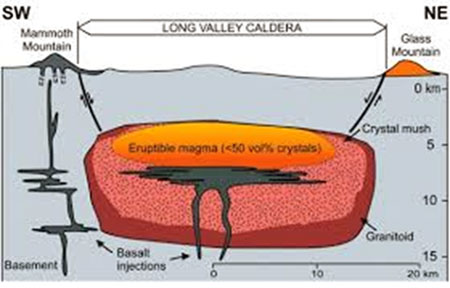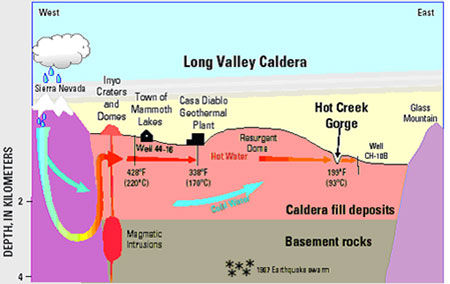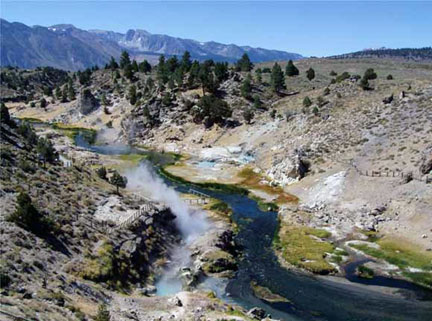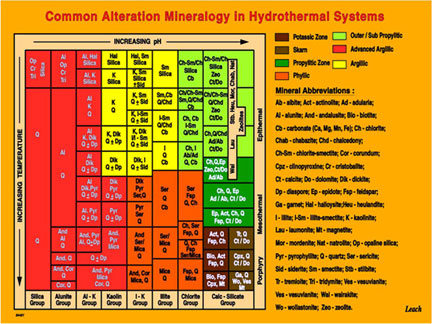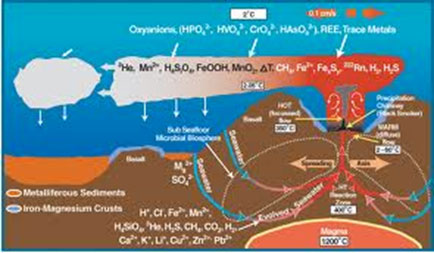Geology and Natural Heritage of the Long Valley Caldera
Process and Results of Hydrology in Long Valley Volcanoes of the Eastern Sierra Nevada Course
Leigh Dukeman
Abstract
Hydrothermal activity is a process responsible for much of the topography of the Sierra Nevada Mountain Range, and specifically the Long Valley. In fact, many of the physical and chemical properties of the landforms in the Long Valley Caldera are the result of hydrothermal systems: powerful forces that are responsible for helping create the area’s vast amount of mineral deposits; mineral deposits that are mined for use in industry, medicine, electronics and for thousands of other applications. Geologically, hydrologic systems are still leaving their mark on this region, and there is little doubt that the abundance of minerals produced within their footprint affects our lives every day, as you will come to see by the conclusion of this discussion.
Introduction
The term "hydrothermal" literally means, "hot water." Hydrothermal systems can only be found in areas of volcanic activity and only under specific conditions. These conditions include the "resupply of magma to sustain continued volcanism and high convective heat flow and active faulting to provide open channels for fluid convection" (Sorey, M, 1985, p. 11,219). All of these conditions are met in the Long Valley Caldera, making this region perfect for hydrology and the creation of a vast amount of mineral deposits. Very few regions in the world are able to utilize and experience the affects caused by hydrology in the same way as those in Long Valley. A majority of the mineral deposits specifically formed in the Long Valley region can be found "on the resurgent dome, at Little Hot Creek Springs, Hot Creek Gorge, and in other locations in the south and east moats of the caldera" (USGS website). Although most of the volcanic activity and hydrothermal activity takes place at the resurgent dome, hydrothermal systems as a whole affect the entire Long Valley region and areas beyond.
Hydrology Process
Where there is evidence of volcanic activity, you will find magma chambers, and in terms of the impact of these activities, Long Valley is a nearly perfect outdoor classroom for study and research. Magma chambers located beneath the Earth’s surface are full of minerals and hot waters that are able to carry the soluble components of the magma chamber when these minerals become dissolved in the water. There’s an active magma chamber underlying Long Valley Caldera, which is "thought to be at a depth of 6-8 km" (Ponko and Sanders, 1994). As magma rises, it comes into contact with the groundwater beneath the surface, causing the water to heat and circulate around the area.
An image of the magma chamber underlying Long Valley, including depth measurements
As the water surrounding the walls of the magma chamber is heated, the water begins to rise towards the surface, carrying minerals from the magma chamber dissolved in the hydrothermal fluids. This is caused by the density of the water being lowered as a result of being under extreme pressure. Normally, hot water would not have a lower density, but the water is "kept from boiling by high pressure," it will then have a "lower density than cold water" (Farrar, C., Evans, W., Venezky, D., Hurwitz, S., andOliver, L., 2007, p. 2). The water, now super-pressurized, will make its ascent by traveling through inclined cracks in the Earth’s surface; mostly observed as fractures created by volcanic activity. These fractures provide zones for the water to move easily through the ground. Like blood in the human body that reaches the capillaries through pressure cause by the pumping heart, pressurized water surges through the fractures until it reaches its end point, which is often the Earth’s surface. As the fluids rise, the fluid "picks up more minerals from the surrounding rock" to add some of the minerals that will eventually be deposited (http://mivo-sys.tripod.com).
Above is a diagram of Long Valley showing the flow of hydrothermal solutions, the average temperatures as the solutions travel through the fractures, and the depth beneath the surface
As this hydrothermal solution pumps along these fractures, the temperatures drop and the solution precipitates out ore constituents. The fractures specifically in Long Valley mostly run from west to east traveling through what is called the west moat. The hydrothermal solutions decrease from about 220°C to 93° as they travel east. Temperature, pressure, and solubility levels of the minerals determine where and when they are deposited along the fractures. The less soluble minerals will precipitate out earlier, closer to the magma chamber. The other materials that have higher solubility levels, dependent on the heat and pressure of the water, precipitate out closer to the surface. The water will then continue moving towards the Earth’s surface and discharge nearby in hot springs. Because not all the minerals reach a low enough temperature and pressure rate to no longer be soluble, some of the minerals remain in a dissolved state when discharged at the surface. Some, but not all of these minerals include "alunite, natrolunite, jarosite, gypsum, kaolinite, dickite, diaspore, pyrophyllite, silica residue, cristobalite, hematite, barite, epidote, wairakite, prehnite, travertine, halloysite, pyrite, aragonite, and trona" (http://mivo-sys.tripod.com). An abundant amount of sulfuric materials, the most common mineral deposit, are released at the surface, which explains the strong, pungent smell when you visit a nearby hot spring. Hot springs are one of the main points where hydrothermal fluids are released at the surface.
In the Long Valley Caldera, water is discharged mostly "at the surface along Hot Creek and around Crowley Lake" (Farrar, C., Evans, W., Venezky, D., Hurwitz, S., and Oliver, L, 2007, p. 2). Hot Creek has temperature much higher than a typical creek around the world because the ground water is still very hot when it reaches the surface here and deposits the remaining fluids. Some of these mineral deposits can also be found in hot springs, geysers, and fumaroles in the area, which are features all associated with hydrothermal activity. These features, while fascinating, can be quite dangerous and should be visited with caution. Many fatalities have been associated with hot springs, geysers, and fumaroles, which has prompted authorities to make some of these areas off limits in the interest of public safety. These hydrothermal features still provide excellent information to geologists studying the minerals and hydrology of this area.
Image of Hot Creek, where some of Long Valley’s minerals are deposited at the surface
Interestingly, while the abundance of these minerals added at the surface makes the water it is deposited into unsafe to drink, it can still support fish life. And, although this activity causes the temperature of the Hot Creek Fish Hatchery, located on the edge of the Long Valley caldera, to rise by ˜5°C (USGS website), this increased temperature actually increases fish production because trout growth-rates are faster in warmer waters (USGS website). Oddly, the abundance of mineral deposits does not seem to have a negative affect on fish life. In fact the opposite is true, this area is very popular for tourists to come for fishing.
Alteration Process
The process known as "alteration" is also is an important process of hydrothermal activity that affects the mineral deposits of this area. Some minerals are not very stable, and therefore, undergo replacement reactions; these reactions alter the original mineral compositions, creating a new, more chemically stable material. After a mineral dissolves in water, it must be higher on the solubility scale to avoid an alteration. Kaolinite is one of the materials in the Long Valley Caldera that underwent alteration as a result of hydrothermal solutions. When potassium feldspar is combined with water, feldspar does not have a high enough stability. The reaction alters the material into kaolinite. Another phenomenon common to volcanic regions is the appearance of rusty materials, which are the result of iron rich sulfates and oxides caused by the alteration process. The alteration process can create new materials that would otherwise not exist, making them unique to the Long Valley and other active hydrothermal regions.
The diagram above shows the minerals that undergo alterations and the conditions that must be met for these alterations to occur. Temperature and the pH level can determine how the minerals will be altered.
The alteration process can make stability for landform structures in volcanic regions difficult due to "acidic alterations in the soil" (mivo-sys.tripod.com). The surface is very flakey in some parts and can be easily pulled away from the surface. The resurgent dome is an example of a volcanic structure full of altered materials. This unstable surface can lead to problems like avalanches as a result of flash floods and too much pressure.
Some alterations made to minerals can be weak, making it difficult to distinguish alterations from weathering. Other alterations completely change the composition of the rock, making it unrecognizable in comparison to its original state. This is all dependent on the stabilities of the materials involved and the reactions that occur. Sometimes "rock alteration leads to misidentification of lithology" (Shanks III, 2012, p. 170). This just shows how important it is to understand the process and each of the minerals involved.
Mineral Deposits Good for Mining
Mineral deposits and alterations to some of these minerals in the Long Valley region are responsible for the high levels of mining activity. Gold, for example, is one of the popular minerals in this area and is one of the catalysts that helped create the California Gold Rush. Nearby towns, such as Bodie, were solely established to provide living quarters and supplies for those miners seeking their portion of gold mineral deposits. While Bodie and other mining towns aren’t directly located in the caldera, they’re located nearby, and therefore still experienced similar hydrothermal aspects. Other prospectors sought a variety of precious mining minerals, like silver and copper, which can also be found deposited along these fractures. The deserted Kaolinite mine-Kaolinite is a material created by the alteration process, in the Resurgent Dome–was also a once-popular place for mining activities.
However, changes in California’s mining process have caused many mines to be left abandoned. California has implemented strict regulations, which makes mining for profit far more challenging in the present day. There are good reasons though for the state taking these regulatory actions. Specifically, California has recognized how destructive mining can be on the environment, and as a result now requires businesses to restore the areas they mine to their original condition. Because of these strict requirements, it is very difficult for individual prospectors or small mining companies to compete profitably. However, in the light of the destruction left behind by past practices, the trade-off has been a positive one in terms of the local Long Valley environment. Many of the remaining ore constitutes are being left in the ground and more of these deposits will continue to collect as the hydrologic systems channel fluids through the Long Valley’s fractures. In addition, it keeps out all the mining equipment and factors that would otherwise be polluting the air. Some areas are still being mined for more minerals, however, the amount of mining has dramatically decreased.
Additional Benefits from Hydrothermal Systems
Despite the benefits derived from the hydrothermal systems by profit mining for ore, California has decided a better approach is to harness this resource by creating geothermal power plants. Areas with volcanic activity have a high geothermal gradient, making the Long Valley Caldera an ideal spot for business. Also certain ideal characteristics such as "various forms of hot spring activity, indicating that heat is crossing the earth’s surface at an anomalous rate" make for a good geothermal power plant location (Lachenbruch, A. and Sorey, M., 1976, p. 763). This process works by allowing these plants to drill wells several kilometers deep into the side of the resurgent dome. "Isobutene," a secondary fluid, is "heated by the pressurized geothermal water," then is converted into energy after being "run through generating turbines" (USGS website). This steam is used to provide energy to help power nearby areas. Geothermal energy is becoming increasingly more popular because it uses a force that already exists in nature, making it more ecofriendly. With a recent push in ecofriendly energy sources, hydrologic systems are being increasingly utilized as one of these providers. Casa Diablo is one of the main drilling sites on the side of the Resurgent Dome. Unfortunately, over years of use, the average amount of "thermal-spring discharge within about 5km to the east of Casa Diablo" has decreased (USGS website). More research needs to be done on how this will affect the hydrothermal activity in the long run. After all, the use of geothermal energy is meant to be a more environmentally friendly way to receive power.
Hydrothermal Activity is also a great tool for volcanic hazard mitigation. By observing hydrology in the area, it can help scientists predict volcanic activity. For example, the locations of hot springs and rocks/sediments that have undergone alteration provide evidence that volcanic processes are still going on beneath the surface. If the active magma chamber weren’t there, the springs would no longer be fed hydrothermal solutions. If there’s a sudden change in the hot springs, it’s a good indicator something has changed beneath the Earth’s surface that requires further investigation. Also, changes in fumaroles and geysers provide evidence that a change in activity has occurred. If a geyser were to suddenly erupt, this could be evidence that the hydrology has been altered. If the minerals that are released at the surface also show change in composition, this is also a strong indicator a change in the system has occurred.
A variety of events or occurrences can cause variations in hydrologic systems. Man’s activities can be one of these factors because geothermal energy plants can mistakenly draw out more water than the supply, changing the ground water levels. Also, water levels around the resurgent dome have shown the "effects of pressure reductions caused by the withdrawal of geothermal fluid" (USGS website). Additionally, earthquakes can cause the area’s water levels to temporarily drop, effecting hydrology. Crustal deformation can cause transformations in hydrologic systems, dropping the water levels temporarily. Although, crustal deformation would have to occur in "relatively high strain rates" to make a noticeable difference in the water levels (USGS website). The levels of precipitation and ground water recharges are also constantly affecting water levels. In recent history, Long Valley has experienced a draught, lowering the overall water levels. This system relies on being "recharged primarily from snow-melt in the highlands around the western and southern rims of the caldera" (USGS website). Without this recharge, the overall amounts of ground water below the surface will be lowered, which is utilized by the hydrologic systems.
These changes affect the hydrology of the area and will in turn also affect the mineral deposits and other materials created by the hydrothermal activity. If the impact of these events causes changes in temperature, it can determine when and where minerals become deposited along the fractures. For example, some materials could stop being released at the surface because the temperature and pressure rates might reach a low enough point that they no longer stay dissolved in the hydrothermal solutions. This could, in turn, change the overall composition of the water sources where the fluids are discharged. Even the smallest changes to the system can have lasting marks the caldera.
Hydrology Around the World
While the focus of this research is on the hydrothermal activity in the Sierra Nevadas, this activity is also very present in other regions of the world. Yellowstone in Wyoming is a very active hydrothermal spot with a vast collection of mineral deposits as well. Oceanic regions are also ideal zones for hydrothermal systems. The ocean waters provide a constant source of water to make this process possible. In fact, oceans are the most common location for hydrothermal activity. While hot springs, fumaroles, and geysers are found on land, black smokers are the hydrological feature associates with oceanic hydrology. Even though these hydrology systems are in the ocean, the process is sill very similar to most land systems. The magma chambers are located deep in the ocean floors and still heat up water that will climb up through cracks, precipitating out ore constitutes. What minerals are deposited vary from system to system, however, because the temperatures, pressure rates, and minerals located along the fractures are inconsistent in different regions.
This is a diagram of the hydrothermal activity process in oceans.
All of these areas with strong hydrothermal systems having unique features and produce unique sediments at and below the surface. While their systems may be similar, each one is not quite like the other. The alterations that occur and materials that are produced are also distinctive in different areas of the world, which supports how unique the Long Valley caldera is and why it is such a treasure trove for studying different geological processes.
Conclusion
It’s hard to imagine Long Valley without the hydrological systems making their impact. It’s difficult to see the dramatic impact they have from an outsider’s perspective, but after study, you can see their role is immense. Without their presence, the area would be entirely unrecognizable. In addition, humans would not experience all their benefits. Who knew such a complex process could be going on beneath the surface in such a desolate/uninhabited area?
References
Hydrothermal Activity. Retrieved from http://mivo-sys.tripod.com/hydro.html
W.C. Pat Shanks III. (2012). Hydrothermal Alteration. http://pubs.usgs.gov/sir/2010/5070/c/Chapter11SIR10-5070-C-3.pdf
Blackwell, D. (1985). A transient model of the geothermal system of the Long Valley caldera, California. Journal of Geophysical Research, 90(13), 11,229-11,241.
Farrar, C., Soreya, M., Roelo, E., Galloway, D., Howle, J., and Jacobson, R. (2003). Inferences on the hydrothermal system beneath the resurgent dome in Long Valley Caldera, east-central California, USA, from recent pumping tests and geochemical sampling. Journal of Volcanology and Geothermal Research, (127), 305-328. Retrieved from http://www.elsevier.com/locate/jvolgeores
Hurwitz, S., Farrar, C., and Williams, C. (2010). The thermal regime in the resurgent dome of Long Valley caldera, California: Inferences from precision temperature logs in deep wells. Journal of Volcanology and Geothermal Research, (198), 233-240. Retrieved from http://www.elsevier.com/locate/jvolgeores
Lachenbruch, A. and Sorey, M. (1976). The near-surface hydrothermal regime of Long Valley caldera. Journal of Geophysical Research, 81(5), 763-768.
Ponko, S.C., Sanders, C.O. (1994). Inversion for P and S wave attenuation structure, Long Valley caldera, California. Journal of Geophysical Research, 99, 2619-2635.
Sorey, M. (1985). Evolution and present state of the hydrothermal system in Long Valley caldera. Journal of Geophysical Research, 90(13), 11,219-11,228.
USGS - Farrar, C., Evans, W., Venezky, D., Hurwitz, S., and Oliver, L. (2007). Boiling Water at Hot Creek–The Dangerous and Dynamic Thermal Springs in California’s Long Valley Caldera. Retrieved from http://pubs.usgs.gov/fs/2007/3045/
USGS. Long Valley Caldera Hydrologic Studies. Retrieved from http://pubs.usgs.gov/dds/dds-81/Intro/MonitoringData/Hydrologic/Hydro.html
[Return to Research Projects] [Return to Sierra Home]
